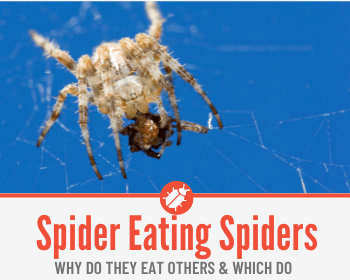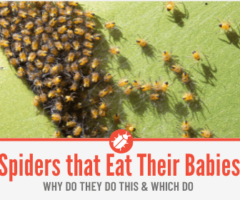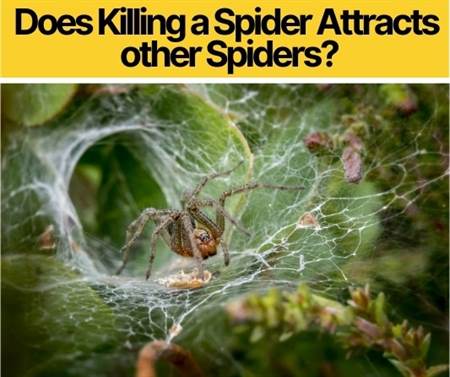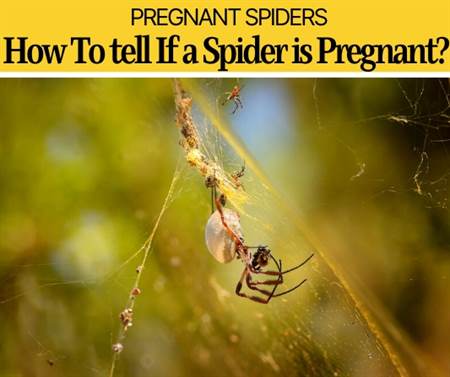 If there is one thing most people can agree upon, it’s that spiders tend to give us all the heebie-jeebies.
If there is one thing most people can agree upon, it’s that spiders tend to give us all the heebie-jeebies.
If you’re that person, you’re not to blame.
But, if you learn a little about them, you might just find them a little less daunting the next time you come across one.
In this article, you’ll learn some interesting factoids such as whether or not they have a cannibalistic side and which species lean this way.
Let’s take a closer look!
Do Spiders Eat Other Spiders?
Yes, spiders most certainly do eat Other spiders! In fact, it is even quite common for a spider to eat another spider, and in some cases, size doesn’t matter at all.
And in more creepy cases, the other spider being of the same species (or god forbid, a mate) won’t make a difference either.
Why do Spiders Eat Each Other
Typically, the main reason a spider will eat another spider is simply that it’s a source of food.
On the other hand, sometimes it is an act of dominance: they do it just because they can.
A great example of the latter reason is displayed in reproductive cannibalism, which is when the female eats the male during copulation.
As odd as that may sound, it can be a common trait, specifically for the black widow. These spiders are known for reproductive cannibalism: they mate and then devour in one fell swoop, thus acquiring the “widow” in their name.
House Spiders
The common house spider mostly thrives on eating insects and other pests that make their way indoors. But, yes, sometimes even prey on other spiders if food is scarce.
Daddy Long Legs
Daddy long legs are omnivores, so their diet consists of not only a variety of insects but spiders as well. It is a common source of food for them.
Fun fact: you may know this spider by another name, the harvestman. They get this name because they are sometimes found traveling in groups of other daddy long legs, strictly during autumn.
Wolf Spiders
Yes. In fact, wolf spiders mostly eat spiders (among other insects of course).
The wolf spider is a natural predator, meaning they prey on their food by ambushing, thus giving justice to their menacing-sounding namesake.
Even to other spiders, the wolf spider poses a threat.
Jumping Spiders
Similar to the wolf spider, jumping spiders prey on their food by sneaking up and ambushing.
Again, among many insects being their primary source of nutrition, spiders too fall under that category.
Though they will eat other spiders, they generally go after ones equal or lesser in size.
Tarantulas
Tarantulas are carnivores, so large insects and other spiders make up most of their diet.
Though, unlike jumping spiders, tarantulas are fiercer, so they prey on spiders regardless of size.
Fun fact: they don’t eat their food as other spiders do. They suck their meal in a liquefied fashion due to their inability to digest solids.
Plus, they eat their prey alive. *shivers*
Huntsman Spiders
The huntsman spider isn’t as commonly known to eat other spiders.
However, their main source of food comes from preying on insects and other invertebrates, which can include spiders.
Cellar Spiders
This one is a resounding “yes”! They are widely known for including spiders in their diet, primarily large house spiders. But, they don’t discriminate when it comes to size. They will eat smaller spiders as well as larger ones, similar to the wolf spider.
Since they act as a natural pesticide by eating up the other unwanted bugs, they’re not so bad to keep around in your basement. Fewer pests we have to deal with!
Another species that acts in the same fashion as the cellar spider is the brown recluse.
True, it is a relative of the black widow, but they are similar to the cellar spider in that they tend to be advantageous for humans to have around: they prey at night, eating up the insects and other spiders roaming around. (Thanks brown recluse!)
Do Baby Spiders Eat Each Other?
This one might be a little surprising if you don’t know much about spiders. The answer is, “yes”. When a baby spider first enters the world it is not uncommon for its first meal to be a sibling spiderling.
If that’s the first thing the baby spider sees, then that’s the first thing in its belly.
A great example is the cat spider. These spiders are a kind of orb-weaver, also called the “jewel spider”.
Because it is so common for the female cat spider to die only days after laying her eggs, the little spiderlings are then free to feast on each other. (Food is food, right?)
In some cases, spiderlings have been known to feed off their own mother. There is even a term for it: matriphagy, aka, mother-eating.
Do Spiders Eat Other Spiders’ Egg Sacs
This is also something that can happen among spiders. But, the egg sacs are always well-protected by the mother, and only on the rarest of occasions will the mother feed on any of her born spiderlings.
Why do female spiders eat each other
It is actually not a well-known thing whether female spiders tend to eat other female spiders or not. They do, however, have a known inclination for eating their mates after sex (ref. above the “black widow”).
What Other Types Of Spiders Eat Other Spiders
Since it is a fairly common practice for a spider to eat another spider, I’ve highlighted below several other kinds that really stand out:
- Pelican spiders, aka “assassin spiders”, are a very ancient species of spider (as ancient as the Jurassic period in fact). These spiders have fed on other spiders since their genesis, and this has been their main source of food ever since. Of course, the reason for this is probably due to the lack of other species that evolved at the same time as the pelican spider. Still, they are the O.G. when it comes to spider cannibalism.
- The pirate spider is another perfect example. They are known for one thing, and that is thievery (aside from consuming their fellow spiders, that is). Instead of making their own webs, they hunt out a suitable web, lure the host spider towards them, and then attack and feast on their fallen prey, taking over what is now their home.
Hence, they get their name “pirate”. Because this is how they make their way in the world, other spiders are a primary piece of their diet, more so than other insects or bugs they may happen to eat too.
- Garden spiders have a similar use as the common house spider or cellar spider. The garden spider (aka writing spider) lives outdoors in places of lush greenery, and therefore helps us in keeping plant-destroying insects out of our flourishing flowers and shrubbery.
They catch their prey using their webs, so if another spider or insect wanders into one, then there goes one less pest skittering around our plants!
- The orb-weaver is the spider that builds those infamous spherical webs we all think of when we hear the word “spider”. Like garden spiders, orb-weavers are also found outdoors, but they are also known for exhibiting cannibalism after copulation.
Related Questions.
Do Spiders Attack Other Spiders?
The overall answer to this question is, “yes”.
First, if they are predatory spiders they definitely will.
Second, in certain cases, a female spider will attack and then kill a male after copulation (ref. “reproductive cannibalism” above).
Lastly, an obvious example of a spider attacking another spider is when one seeks out and invades another spiders’ web, aka the life of a pirate spider (ref. “pirate spider” above).
Dead or Alive?
Do spiders eat other dead spiders?
Honestly, yes. To them, it is just another meal. Eating the corpse of another spider is common in spiderlings, who have been known to eat their mother once she dies. (Yep, just another meal.)
On the flip side to this, it also doesn’t matter whether the spider is alive. If there is food to be had, they’ll go for it.
What Have We Learned
Although spiders may be the epitome of fear for some of us, once you begin learning about them – you can’t lie – they’re kind of interesting!
Not only do spiders ward off many annoying bugs by eating them up, but they also sometimes eat their own kind.
Yes, perhaps creepy, but in reality that just means one less spider we have to worry about finding in a dark corner of our house. They may just be less of a nuisance than we think they are.






